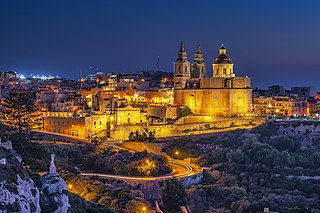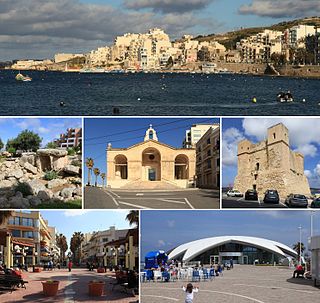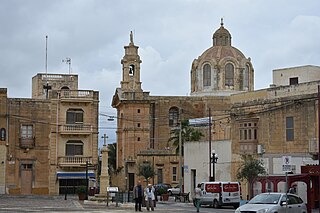
Mellieħa is a large village in the Northern Region of Malta. It has a population of 10,087 as of March 2014. Mellieħa is also a tourist resort, popular for its sandy beaches, natural environment, and Popeye Village nearby.

Saint Julian's is a town in the Eastern Region of Malta. As of 2020, its registered number of inhabitants stands at 13,792. It is situated along the coast, north of the country's capital, Valletta. It is known for tourism-oriented businesses, such as hotels, restaurants and nightclubs which are centred mainly in an area known as Paceville.

Saint Paul's Bay is a town located on the northeast coast of Malta in the Northern Region. It is a major residential and commercial area and a centre for shopping, bars, dining, and café life. As per the 2021 population census, it has also become the most populated town in the country.

Sliema is a town located on the northeast coast of Malta in the Northern Harbour District. It is a major residential and commercial area and a centre for shopping, bars, dining, and café life. It is also the most densely populated town on the island.

Fort San Lucian, also known as Saint Lucian Tower or Fort Rohan, is a large bastioned watchtower and polygonal fort in Marsaxlokk, Malta. The original tower was built by the Order of Saint John between 1610 and 1611, being the second of six Wignacourt towers.

Qawra Tower, also known as Qawra Point Tower or Fra Ben Tower, is a small watchtower in Qawra, limits of St. Paul's Bay, Malta. It was completed in 1638 as the fourth of the Lascaris towers. An artillery battery was built around the tower in 1715. Today, the tower and battery are a restaurant.

Wignacourt Tower, also known as Saint Paul's Bay Tower, is a bastioned watchtower in St. Paul's Bay, Malta. It was the first of six Wignacourt towers to be built, and the first stone was laid on 10 February 1610. It replaced the role of Ta' Tabibu farmhouse which was previously known as Dejma Tower. An artillery battery was added a century later in 1715. Today the tower is a museum of fortifications around the Maltese Islands.

Nadur is an administrative unit of Malta, located in the eastern part of the island of Gozo. Nadur is built on a plateau and is one of the largest localities in Gozo. Known as the 'second city', it spreads along a high ridge to the east of Victoria. It had a population of 4,509 as of March 2014.

Marsaskala, sometimes written as Marsascala is a seaside town in the South Eastern Region of Malta. Originally a fishing village, it has grown into a tourist destination and a permanent hometown for an ever-growing population.

Buġibba is a zone within St. Paul's Bay in the Northern Region, Malta. Situated adjacent to Qawra, it is a popular tourist resort, containing numerous hotels, restaurants, pubs, archit clubs, and a casino.

Maltese architecture has its origins in prehistory, and some of the oldest free-standing structures on Earth – a series of megalithic temples – can be found on Malta. The islands were colonized by the Phoenicians and later the Romans, who established the cities of Melite and Gaulos. Although these were substantial settlements and are known to have had numerous temples, churches and palaces, few remains have survived apart from some architectural fragments.

Baħar iċ-Ċagħaq is an urban village in Malta situated between the limits of Madliena, Magħtab, Għargħur and Pembroke. The area is situated at the mouth of the island's longest valley called 'Wied il-Kbir'. The name Baħar iċ-Ċagħaq in Maltese can be translated to 'sea of pebbles' in English. It has a population of approximately 1,250 people.
This page list topics related to Malta.

The coastline of Malta consists of bays, sandy beaches, creeks, harbours, small villages, cities, cliffs, valleys, and other interesting sites. Here, there is a list of these different natural features that are found around the coast of Malta.
The Lascaris Towers are a series of mostly small coastal watchtowers built in Malta by the Order of Saint John between 1637 and 1652. The first seven towers were built around the coast of mainland Malta in 1637 and 1638. Between 1647 and 1652, a large tower was also built on mainland Malta, and two smaller ones were built on Gozo.

The fortifications of Malta consist of a number of walled cities, citadels, forts, towers, batteries, redoubts, entrenchments and pillboxes. The fortifications were built over hundreds of years, from around 1450 BC to the mid-20th century, and they are a result of the Maltese islands' strategic position and natural harbours, which have made them very desirable for various powers.

Sliema Point Battery, also known as Fort Sliema, is an artillery battery in Sliema, Malta. It was built by the British between 1872 and 1876. The battery stands on the peninsula that separates Marsamxett Harbour from St. Julian's Bay. The battery was later used as a searchlight position, and it is now a restaurant known as Il-Fortizza.

Buġibba Temple is a megalithic temple on the border of Buġibba and Qawra towns, limits of St. Paul's Bay, Malta. A hotel was built on the grounds of the temple.

Buġibba Battery, also known as Elbene Battery, was an artillery battery in Buġibba, limits of St. Paul's Bay, Malta. It was built in the 18th century, by the Order of St. John, as one of a series of coastal fortifications around the coasts of the Maltese islands. The battery no longer exists, but its rock-hewn ditch and some foundations can still be noticed.


















